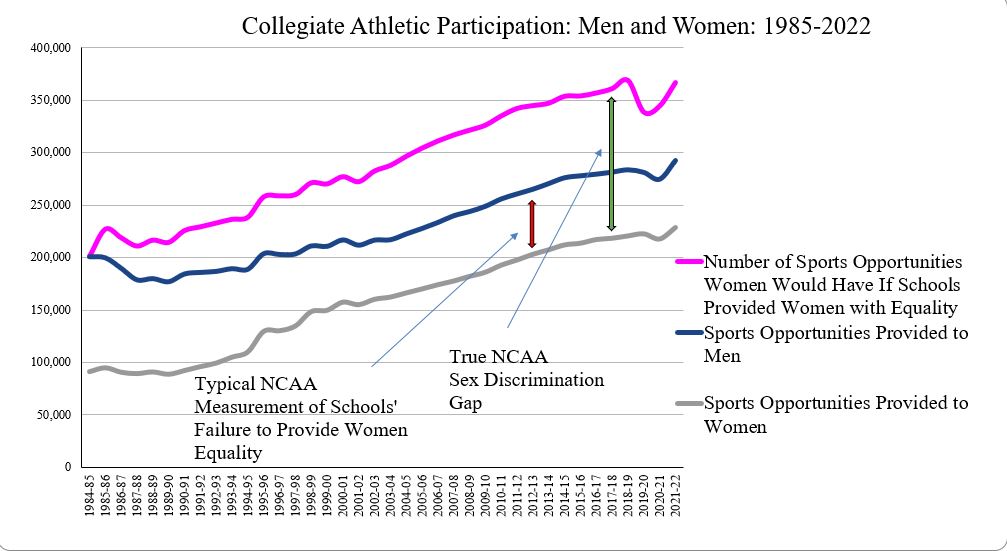Champion Women performed an in-depth analysis of data available from the Equity in Athletics Disclosure Act. Because athletics is sex-segregated, discrimination and gaps are fairly easy to measure. The data shows discrimination throughout intercollegiate sports and that the inequality is growing at an unrestrained rate. Key findings include:
- 92.7% of universities and colleges discriminate against women’s opportunities in sports. Our analysis shows that most intercollegiate athletic departments are not meeting any of the standards Title IX sets for schools to demonstrate equality in sports opportunities.
- Women miss out on more than $1.1 billion in athletics scholarships annually. Colleges and Universities allocate a total of $4.6 billion to men’s and women’s athletics scholarships, yet female student-athletes should be getting over a billion dollars more if they had the same opportunities that are provided to men.
- Colleges and Universities collectively need to provide an additional 225,568 sports opportunities to women in order to match the same proportion of opportunities that are offered to men.
Women cannot move to another competitive tier or geographic region to escape the sex discrimination. Data for the NCAA’s three divisions, the NAIA, NJCAA, and USCAA paints a clear picture that intentional discrimination against women is not isolated to specific conferences, competitive levels, or geographic regions.

Contrary to the perception by some that Title IX has achieved its goals of equality in collegiate sports, women lag behind men by every measurable criterion, and dramatically so. The RAW Gap in the 2021-2022 academic year between men’s and women’s sports opportunities was a staggering 67,591 women. This means that last year alone, schools provided women with 67,591 fewer sports opportunities than these schools provided men. This means that every one of the 2028 schools that report data to the Department of Education would need to add an average of 33.3 more sports opportunities, enough for one to three new teams, depending on the team.
But that raw number, calculated by subtracting women’s opportunities from men’s, does not reflect the true measure of sex discrimination in athletic departments. Women are not 50% of the student body they are 55.6% of the student body. If universities offered women the same proportionate sports opportunities they provide men, these schools would be offering an additional 225,568 opportunities for women to play each year. Currently, schools are providing 8.58 opportunities to play sports for every 100 male students on campus, but only 14 opportunities for every 100 female students on campus. In the graph above, the green line represents the True Discrimination Gap.
It is misleading to look at the upward trending line for both men’s and women’s sports participation opportunities and claim victory for women and Title IX. Both the Raw Gap and the True Discrimination Gap have been growing since 1989, over 30 years. To achieve equality for women in intercollegiate athletics, we must take into account the faster rate of growth for men’s sports, even when women are attending higher education at higher rates. Although the True Discrimination Gap is more accurate, both the Raw Discrimination Gap and the True Discrimination Gap document immense intentional discrimination in intercollegiate sports.
The upward trend in sports opportunities for men and women doesn’t tell a story about the end of sex discrimination in athletics. In fact, the True Discrimination Gap is much larger than we thought and is only getting larger.
In 2023, we can demonstrate that the chasm separating the athletic opportunities provided to men and women in schools has surged by an astounding 18% since 2001.
- In 13 of the last 19 years, more participation opportunities have been added for men than women.
The strategy of requiring 18-22y/o students to remedy sex discrimination has clearly failed. We call on the Biden Administration and the Office for Civil Rights, the NCAA and conferences to enforce long-standing, popular law, and for Congress to provide remedies that are stronger than merely requiring schools to do what they should have done a decade ago.
Want to know more about your school ? Click this LINK to check your College or University.

